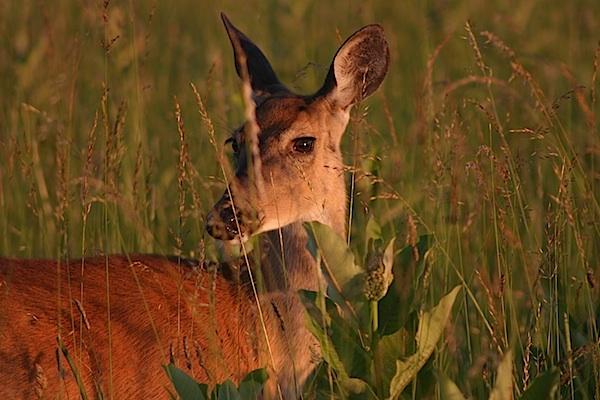
Shenandoah National Park officials are expecting chronic wasting disease to soon infect their white-tailed deer/NPS, Bob Kuhns
With the arrival of chronic wasting disease in Shenandoah National Park deer seemingly imminent, park staff are working on amending its plan for dealing with the disease to allow for the culling of deer to try to limit the spread of the disease.
While CWD has not been found in the park's deer, it has been documented approximately 12 miles from the park's northern boundary, a park release said.
"The spread of the disease into the park appears imminent, and park staff has determined that a plan for managing the disease is needed. CWD is a serious, non-native disease which threatens deer populations, related natural resources, and visitor experiences at Shenandoah National Park," the release added. "The proposed plan amendment calls for the lethal removal of deer within specific developed areas of Shenandoah National Park to reduce the likelihood of CWD establishment and decrease the disease's progression within the park."
CWD is a self-propagating neurological disease that affects deer and related species, causing brain lesions that result in progressive weight loss, behavioral changes, and eventually death, according to the Park Service.
"If left unmanaged, National Park Service biologists believe CWD could progress rapidly through the park and very significantly impact deer populations inside and outside the park. There is currently no evidence that the disease is transmissible to humans or domestic livestock," the agency added.
The park's 2013 CWD disease detection and assessment plan already approves lethal sampling of up to 314 deer for detecting/assessing CWD. The proposed amendment if approved would allow park staff to manage the disease by lethally removing deer to reduce deer densities in front country areas of the park. Maintaining deer densities that are similar across the park is the primary way to minimize disease transmission and spread, according to the park. The proposed action reduces higher densities of deer in key front country areas to match backcountry densities via lethal removal. During targeted density reduction actions, the park may remove up to 150-200 animals. When combined with detection and assessment, the maximum number of deer that would be lethally removed is approximately 500 deer over a five-year period.
'We regret very much that we have to propose this action, but we must act when the park's deer population is being threatened by an invasive, non-native disease," said Shenandoah Superintendent Jim Northup. "We have a legal obligation to try to protect the ecological integrity of the park. Just like with invasive plants and insects, chronic wasting disease is a wildlife disease that does not occur naturally in this part of the country and must be managed to preserve the long-term viability of the deer population within the park. If we decide to proceed with this action, we will conduct our operations in the most sensitive and humane way possible and make every effort to see that the safe deer meat is donated to those in need. Our long term goal is to make sure that visitors to Shenandoah National Park will have the opportunity to view and appreciate beautiful, healthy deer for generations to come.'
Details of the plan, and a page for public comment, can be found at this website.
Public meetings will be held in various locations around the park. The first informational meeting will be held on Monday, November 17, at the Crozet Public Library, 2020 Library Ave, Crozet, Virginia. The second meeting will be held on Tuesday, November 18, at the Warren County Community Center, 538 Villa Avenue, Front Royal, Virginia. The third meeting will be on Thursday, November 20, 2014 at Elkton Community Center, 20593 Blue and Gold Drive, Elkton, Virginia. All meetings will begin at 7 p.m. and end at 9 p.m.

 Support Essential Coverage of Essential Places
Support Essential Coverage of Essential Places







Comments
But how can a disease be "self propagating" and spread from one deer to another. Doesn't there need to be some kind of vector to transmit it from deer to deer?
I tried Googling it but couldn't find any information that explained it -- at least not simply enough for this bear of little brain to comprehend.
Can someone with greater understanding of biology explain this thing to me?
I think I've heard that it's transmitted by some type of sand nat??
According to the Missouri Department of Conservation:
"Chronic wasting disease infects deer and other members of the deer family, called cervids. CWD belongs to a group of diseases known as transmissible spongiform encephalopathies (TSEs) which cause degeneration of the brain in cervids. CWD is transmitted through prions, which are abnormal proteins that attack the nervous systems of these species. These prions accumulate in the brain, spinal cord, eyes, spleen, and lymph nodes of infected animals.
CWD is spread both directly from deer to deer and indirectly to deer from infected soil and other surfaces. Animals with signs of CWD show changes in natural behavior and can exhibit extreme weight loss, excessive salivation, stumbling, and tremors. CWD in deer can only be confirmed by laboratory tests of brain stem or lymph tissue from harvested animals."
It is 100% fatal. If there are a lot of deer in an area and it starts to spread, it takes quite a few years for the deer population to recover.
More info: http://www.dailyprogress.com/news/local/chronic-wasting-disease-in-deer-...
dahkota comes through with the facts again and even explains so I could understand most of it.
'Tis a bad day when you don't learn something new.